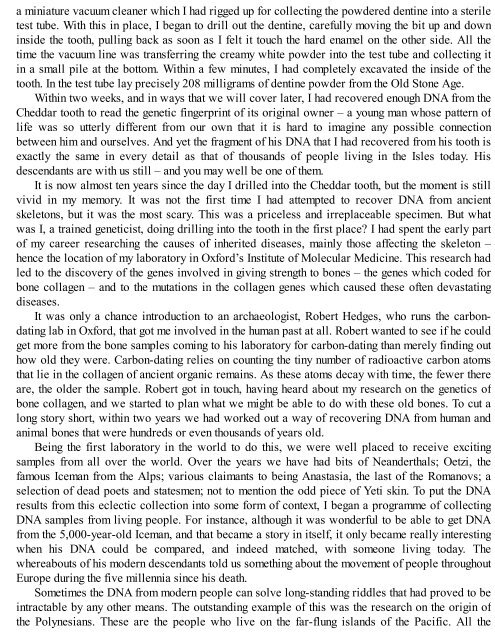You also want an ePaper? Increase the reach of your titles
YUMPU automatically turns print PDFs into web optimized ePapers that Google loves.
a miniature vacuum cleaner which I had rigged up for collecting the powdered dentine into a sterile<br />
test tube. With this in place, I began to drill out the dentine, carefully moving the bit up and down<br />
inside the tooth, pulling back as soon as I felt it touch the hard enamel on the other side. All the<br />
time the vacuum line was transferring the creamy white powder into the test tube and collecting it<br />
in a small pile at the bottom. Within a few minutes, I had completely excavated the inside of the<br />
tooth. In the test tube lay precisely 208 milligrams of dentine powder from the Old Stone Age.<br />
Within two weeks, and in ways that we will cover later, I had recovered enough DNA from the<br />
Cheddar tooth to read the genetic fingerprint of its original owner – a young man whose pattern of<br />
life was so utterly different from our own that it is hard to imagine any possible connection<br />
between him and ourselves. And yet the fragment of his DNA that I had recovered from his tooth is<br />
exactly the same in every detail as that of thousands of people living in the Isles today. His<br />
descendants are with us still – and you may well be one of them.<br />
It is now almost ten years since the day I drilled into the Cheddar tooth, but the moment is still<br />
vivid in my memory. It was not the first time I had attempted to recover DNA from ancient<br />
skeletons, but it was the most scary. This was a priceless and irreplaceable specimen. But what<br />
was I, a trained geneticist, doing drilling into the tooth in the first place? I had spent the early part<br />
of my career researching the causes of inherited diseases, mainly those affecting the skeleton –<br />
hence the location of my laboratory in Oxford’s Institute of Molecular Medicine. This research had<br />
led to the discovery of the genes involved in giving strength to bones – the genes which coded for<br />
bone collagen – and to the mutations in the collagen genes which caused these often devastating<br />
diseases.<br />
It was only a chance introduction to an archaeologist, Robert Hedges, who runs the carbondating<br />
lab in Oxford, that got me involved in the human past at all. Robert wanted to see if he could<br />
get more from the bone samples coming to his laboratory for carbon-dating than merely finding out<br />
how old they were. Carbon-dating relies on counting the tiny number of radioactive carbon atoms<br />
that lie in the collagen of ancient organic remains. As these atoms decay with time, the fewer there<br />
are, the older the sample. Robert got in touch, having heard about my research on the genetics of<br />
bone collagen, and we started to plan what we might be able to do with these old bones. To cut a<br />
long story short, within two years we had worked out a way of recovering DNA from human and<br />
animal bones that were hundreds or even thousands of years old.<br />
Being the first laboratory in the world to do this, we were well placed to receive exciting<br />
samples from all over the world. Over the years we have had bits of Neanderthals; Oetzi, the<br />
famous Iceman from the Alps; various claimants to being Anastasia, the last of the Romanovs; a<br />
selection of dead poets and statesmen; not to mention the odd piece of Yeti skin. To put the DNA<br />
results from this eclectic collection into some form of context, I began a programme of collecting<br />
DNA samples from living people. For instance, although it was wonderful to be able to get DNA<br />
from the 5,000-year-old Iceman, and that became a story in itself, it only became really interesting<br />
when his DNA could be compared, and indeed matched, with someone living today. The<br />
whereabouts of his modern descendants told us something about the movement of people throughout<br />
Europe during the five millennia since his death.<br />
Sometimes the DNA from modern people can solve long-standing riddles that had proved to be<br />
intractable by any other means. The outstanding example of this was the research on the origin of<br />
the Polynesians. These are the people who live on the far-flung islands of the Pacific. All the
















